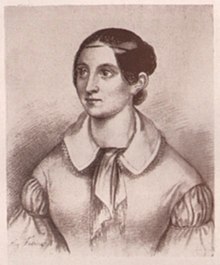Angelica Bellonata Facius

Angelica Bellonata Facius (born August 13, 1806 in Weimar ; † April 17, 1887 there ) was a German sculptor , medalist and gem cutter .
Life
She was the daughter of Friedrich Wilhelm Facius , whom she far exceeded in her abilities. She was a student of Christian Daniel Rauch in Berlin and was strongly influenced by the circle around Goethe in Weimar. After five years of apprenticeship with her father, who was accompanied by attending the Princely Free Drawing School in Weimar, which was sponsored by Goethe , she received further lessons from Peter Kaufmann , the Weimar court sculptor. In 1825 she was presented to Goethe, who encouraged her artistic development. Her unusual talent gave her the support of other well-known personalities such as Leonhard Posch , Gottfried Schadow and the well-known medalist Gottfried Bernhard Loos . In Berlin she spent her apprenticeship with the sculptor Christian Daniel Rauch from 1827 to 1834 and lived temporarily with the composer Karl Friedrich Zelter, who reported to Goethe about her progress in his letters. Angelica Facius is one of the most important German sculptors of the first half of the 19th century and one of the leading Berlin sculpture schools.
Facius main works are works for the Weimar Palace (donation relief with the medallion of Goethe, Victoria reliefs, Apollo heads, but above all the decorative doors) and 19 filigree cameos of important Weimar personalities, which are now kept in Dresden's Green Vault. Her best cuts include the portrait of Grand Duke Karl August von Weimar in a carnelian, the medal to celebrate the jubilee of Grand Duke Karl August von Weimar (1825) and the medal on the death of this prince, which was completed under Rauch's direction. Her portraits in gem style and her busts in plaster, seals and bas-reliefs are also excellent. She created numerous sculptures. According to Brodrecht (see literature), Facius' work is far more extensive, diverse, demanding and independent than previously assumed. Some works are considered lost, but in recent years works such as a rifle cup, the portrait of Schiller on the Schiller album, a statuette of Maria Pavlova, a child bust for Beust, a bust of Zelter's stepdaughter, a shell cameo with a portrait of A. Feodorovna or candelabra figures are rediscovered, so that further discoveries in the future cannot be ruled out.
Angelika Facius is buried in the historical cemetery in Weimar . Her tombstone can be found on the eastern wall of the cemetery.
literature
- General artist lexicon . Volume XXXVI, 2003, p. 159.
- Claude Keisch, Roland März: German visual artists from the time of Goethe to the present. National Gallery, Berlin 1975.
- Peter Bloch et al. (Ed.): Ethos and Pathos, the Berlin Sculpture School 1786–1914. German Association for Art Science, Berlin 1990.
- Eva Wipplinger: Medalists in Germany. Creativity in the past and present . Hall 1992.
- Ulrike Müller (ed.): Female personalities of the Weimar Classics: dealing here seems very pleasant and not at all costly . Weimar 1998, 2003.
- Bärbel Kovalevski (Ed.): Between ideal and reality. Artists of Goethe's time between 1750 and 1850 . Ostfildern-Ruit 1999.
- Maja Brodrecht: Angelica Facius (1806–1887) the life and work of a sculptor of the Goethe era and the late classicism . Dissertation. Jena 2016.
- Maja Brodrecht: The medal in Goethe's garden lake . In search of the Weimar artist A. Facius. Norderstedt 2020, ISBN 978-3-7504-7196-2 .
Web links
| personal data | |
|---|---|
| SURNAME | Facius, Angelica Bellonata |
| ALTERNATIVE NAMES | Facius, Angelica |
| BRIEF DESCRIPTION | German sculptor, medalist and gem cutter |
| DATE OF BIRTH | August 13, 1806 |
| PLACE OF BIRTH | Weimar |
| DATE OF DEATH | April 17, 1887 |
| Place of death | Weimar |

